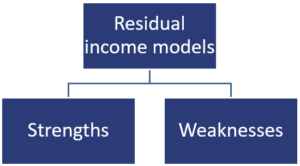Strengths and Weaknesses of Residual Income Models
The residual income model is a valuation model that starts with the company’s book value and that adds to this the present value of the expected stream of residual income. In principle, the intrinsic value derived from expected dividends, expected cash flows or residual income should be the same. In reality, different models yield different results. The difference can mainly be explained by different underlying assumptions.
On this page, we discuss the strengths and weaknesses of using residual income models. More details on the residual income model can be found here.
Residual income model strengths
Strengths of residual income models include the following:
- Terminal value does not dominate the intrinsic value estimate, as is the case with dividend discount and free cash flow valuation models
- Residual income models use accounting data, which is usually easy to find
- The models are applicable to firms that do not pay dividends or that do not have positive expected free cash flows in the short run
- The models are applicable even when cash flows are volatile
- The models focus on economic profitability rather than just on accounting profitability
Residual income model weaknesses
Weaknesses of residual income models include the following:
- The models rely on accounting data that can be manipulated by management
- Reliance on accounting data requires numerous and significant adjustments
- The models assume that the clean surplus relationship holds or that its failure to hold has been properly taken into account
When to use residual income models?
Residual income models are appropriate under the following circumstances:
- A firm does not pay dividends, or the stream of payments is too volatile to be sufficiently predictable
- Expected free cash flows are negative for the foreseeable future
- the terminal value forecast is highly uncertain, which makes dividend discount or free cash flow models less useful
Residual income models are not appropriate under the following circumstances:
- The clean surplus accounting relationship is violated significantly
- There is significant uncertainty concerning the estimates of book value and return on equity.
Summary
We discussed the strengths and weaknesses of residual income models when estimating the intrinsic value of a company.

